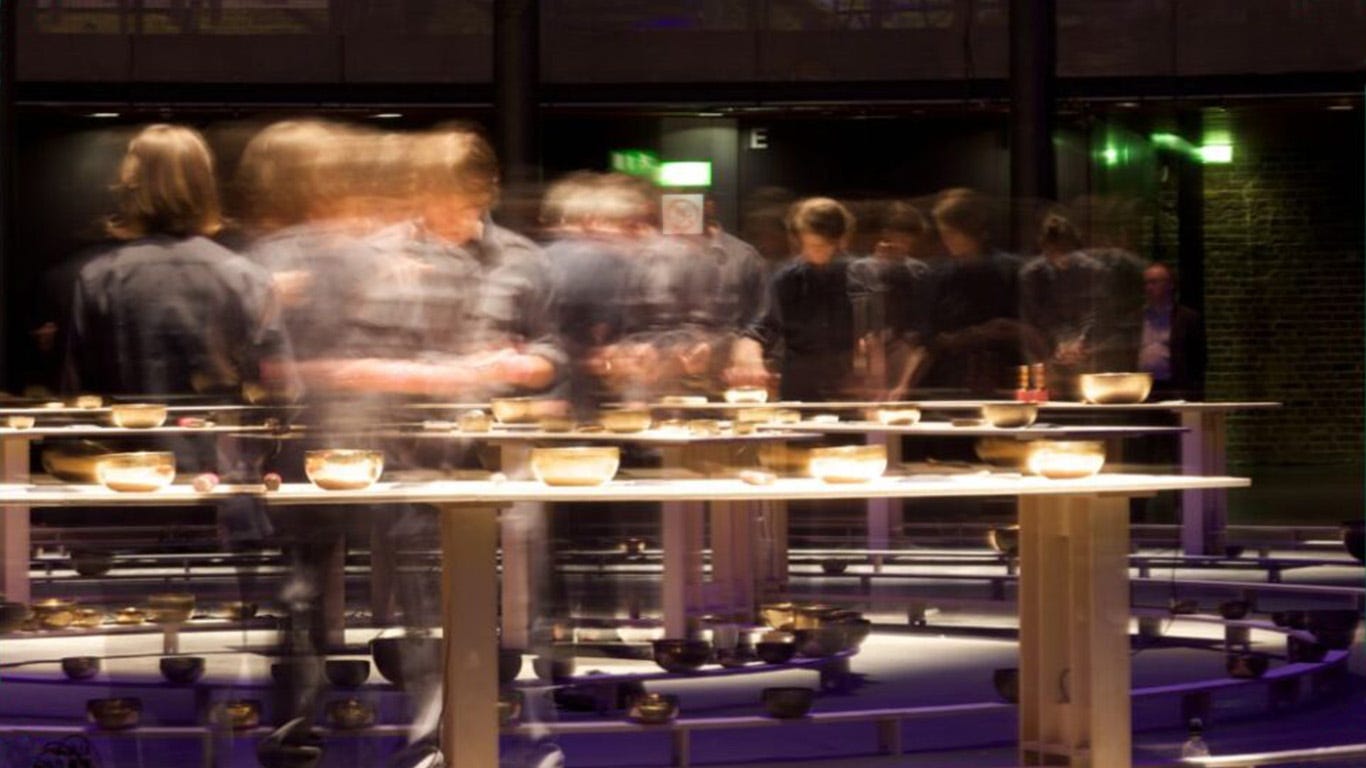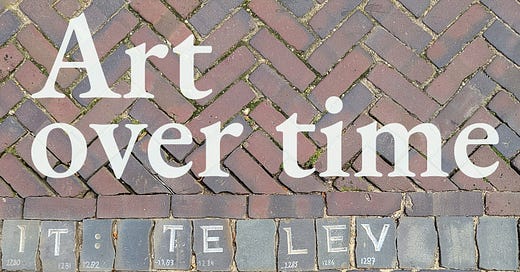Art over time
March 02025 - Booking for walking tours and Longplayer live. Contributions from long-term art project stewards.

In March 02025 our theme is inspired by the upcoming Longplayer Live performance at the Roundhouse and “What Art Does”, the recent book by Bette A and (Long Now co-founder) Brian Eno. We will meet on Thursday 13th at the RSA. For further information on this and future gathering, please see our Luma events calendar. This month’s gathering was oversubscribed at the start of the month so if you want to join us in future, do please follow the Luma page.
On that calendar you will also see an invitation to join our plans for visiting Longplayer Live at various points during the 1,000 minute performance on Saturday 5th April. We’ve also commissioned a walking tour for the day (more of which below).
Christopher Daniel
on behalf of Long Now London

“By A Long Chalk” by Minimum Labyrinth
In celebration of Longplayer Live, we at Long Now London have commissioned a new walking tour by our good friends at Minimum Labyrinth. “By a Long Chalk” has been specially written for the occasion and is an exploration of the environs and history of Chalk Farm and Primrose Hill through the lens of “Pace Layers”, Stewart Brand’s model for the ever-interacting layers of civilisation.
“It is a way of hearing the signal amidst the noise of London: and in this small quarter, making sense of steam trains and secret vaults, geology and gin, duels and druids, tunnels, taverns and towpaths.”
Robert Kingham, Minimum Labyrinth
If you are coming to Longplayer at any point that day, we’d love to see you on one of the walking tours. They are timed to fit with the schedule of events within the Roundhouse.
What have future generations ever done for us?
Longplayer is one of a small group of art projects around the world that explicitly seek to last beyond the lifetimes of their originators, not just as objects but as evolving artworks, existing only in relationship with the care and attention of future generations. Since 02023 the custodians of these projects have been working together to find new ways both to help their projects last and to encourage more such projects to exist. In the book “What Art Does”, Bette A and Brian Eno assert that “Art makes feelings happen”. It is the aim of these art works to help current generations connect with the idea of future generations, and in doing so to encourage care.
In 02024 these projects were gathering as part of the exhibition “Art and Culture for Future Generations” at the UN Headquarters in New York to coincide with the Summit for the Future and the UN General Assembly. That exhibition showcased fifteen projects from around the globe, including our own annual practice of “Chalking the Horse”. Several Long Now London members were involved in the creation of the exhibition.
If any such artwork is to last, it is ultimately reliant on intergenerational collaboration. It is not enough for one generation to play its part and just hand it over to the next. Each generation of caretaker must be encouraged by those who have gone before. In his recent book “The Rise and Fall of Generation Now”, anthropologist Tim Ingold suggests that rather than thinking of generations as stacked one on top of the other, we might imagine them as wrapping one around the other along their length, like fibres in a rope. As many of these Long-Term Art Projects (LTAPs) enter their second generation of stewardship, it feels apt to be doing some second generation thinking, hopefully on our way towards the seventh generation.
To this end, we have asked current stewards of two of the LTAPs to tell us a little about their projects. Please read on for contributions from Sam Kinchin Smith of Longplayer in London and Barbara Laber of the Zeipyramide in Germany.

Longplayer at 25
Sam Kinchin-Smith is head of special projects at the London Review of Books, and the new chair of the Longplayer Trust.
Longplayer, as readers of this newsletter are disproportionally likely to already be aware, is an everlasting piece of music composed by Jem Finer, written to repeat once every thousand years. Its composition results from the application of simple and precise rules to six short pieces of music, played on Tibetan singing bowls. Six sections from these pieces – one from each – are playing simultaneously at all times. Longplayer chooses and combines these sections in such a way that no combination is repeated until exactly a thousand years has passed.
It began playing on the cusp of the new millennium, at midnight on 31 December 01999, and has been performed mostly by computers over the intervening quarter century, though it has also been sung, released on vinyl, encoded through light, and realised live in rare durational performances. The next of these will take place at London’s Roundhouse on Saturday 5 April, when a 1000-minute section will be performed on a large orchestral instrument comprised of 234 singing bowls, arranged in six concentric rings and played by shifts of six to twelve people at any one time, reading from a graphic score.
Longplayer is designed to be adaptable to unforeseeable changes in its technological and social environments, and to endure in the long-term as a self-sustaining institution through the Longplayer Trust, the charity charged with its care. As a newcomer to long-term custodianship, the main thing I feel I have to offer is fresh eyes. This isn’t self-deprecation; it’s an indispensable commodity for any project or institution hoping to achieve sustainability through continuous renewal.
One first impression that may hopefully prove to be a productive avenue of enquiry, is the idea that Longplayer resembles and functions a bit like a secular church – in the sense of both a community (Longplayer’s trustees, supporters, listeners etc.) and sacred spaces (its listening posts). Where what is believed in, is that there will be a reasonably distant human future – with a comprehensible (or at least, traceable) relation to the present. Longplayer Live should be a good opportunity to test this notion.
The Wemding Zeitpyramide
Amongst other things, Barbara Laber is a custodian of the Zeitpyramide and a founder member of the association of Long-Term Art Projects.
The Zeitpyramide (“Time Pyramid”) is a long-term art project conceived by the artist Manfred Laber, which is being realised near the Bavarian town of Wemding. Over a period of twelve hundred years 120 roughly human-height concrete blocks are placed at regular intervals of a decade to eventually form a pyramid arrangement in the year 3183.
The evolving art piece works on various levels: It is a work of “concrete art”, which does not represent anything else but itself and its structural components. At the same time, it is also a conceptual work of art and thus merely the material manifestation of an idea or a concept. Finally, it is a long-term art project which relies on the social context of a community, the stewardship of volunteers and intergenerational responsibility and continuity for its completion.
Concrete as material for Zeitpyramide was a deliberate and conscious choice of the artist. Any other material might have carried a cultural meaning or connotations of status, value and power. Concrete does not come with an age of its own but rather does not exist until it solidifies at the time of casting. As a marker of a moment, it thus “petrifies” a specific point in time.
This time-based nature is emphasized by the specific site at the rim of the meteorite crater Nördlinger Ries. Here a human lifetime is put into perspective by the project’s duration reaching into a distant future and dwarfed to a glimpse against the backdrop of geological deep time left by an impact incident millions of years ago in the past. Standing next to the current four blocks and touching the growing moss on the roughened surface of the oldest block, comparing it to the spotless smoothness of the latest block - especially at night time, when the light of distant stars long gone illuminates the scene – the art work surely serves as a memento mori.
The initial concept was a brainchild of the artist, who formulated a set of rules and parameters for its realisation. Once realized, though, it became part of the world and is now exposed to influences and developments beyond his control. Changing political, social, environmental and cultural circumstances may lead to changes in interpretation, possibly even abandonment, dismissal or misappropriation. Initially Zeitpyramide was confronted with scepticism from parts of the local community, but the more blocks are placed, the more locals seem to develop a personal relationship with it.
A very small group of mainly local volunteers, friends and family of the artist keep the project running, some of them as members of a trust. As his daughter, I only got involved after my father passed away and I became aware of the necessity of future generations for Zeitpyramide to continue. With Lukas Pfaller, who designed an augmented reality visualisation and arranged live streaming of the 2023 block placement, new technologies have started to expand and enhance the original scope of the project. The baton has definitely been passed.
And what happens when the last block is finally placed and the pyramid completed? Is this still a long-term art project then? Or will it have turned into a sculpture? When is the time to call it a gradually decaying ruin?
The next block is scheduled to be placed in the year 2033. All at Long Now London will be welcome in Wemding.
So this newsletter is a little shorter than last month (and a little later). The experiments with content will continue. Whatever your thoughts on any or all of it, we would love to hear from you, whether via email or in person.
Here is a little more information about the current LTAPs:
De Letters van Utrecht, The Netherlands.
The Future Library, Norway.
Longplayer, UK.
ORGAN²/ASLSP, Germany.
The Zeitpyramide, Germany.
Do you know of another project that could be added to this community? If so, please do let us know.
Representatives of these projects will be joining us in London on the weekend of 4th to 6th April for a weekend centred on the Longplayer Live performance. This will include a small symposium on the Sunday afternoon. If you would like to attend, please do email us, with mention of how you might hope to contribute to the focussed conversation on that day. We hope to include as wide a range of interested voices as possible.




